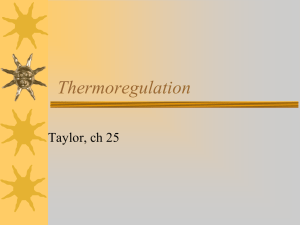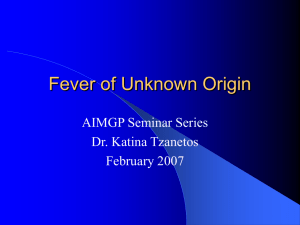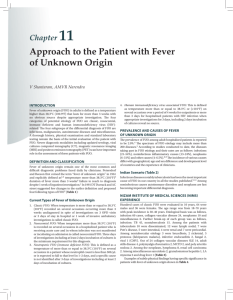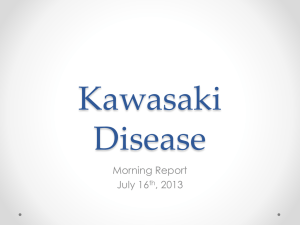Cardinal Manifestations of Disease: ALTERATIONS
advertisement
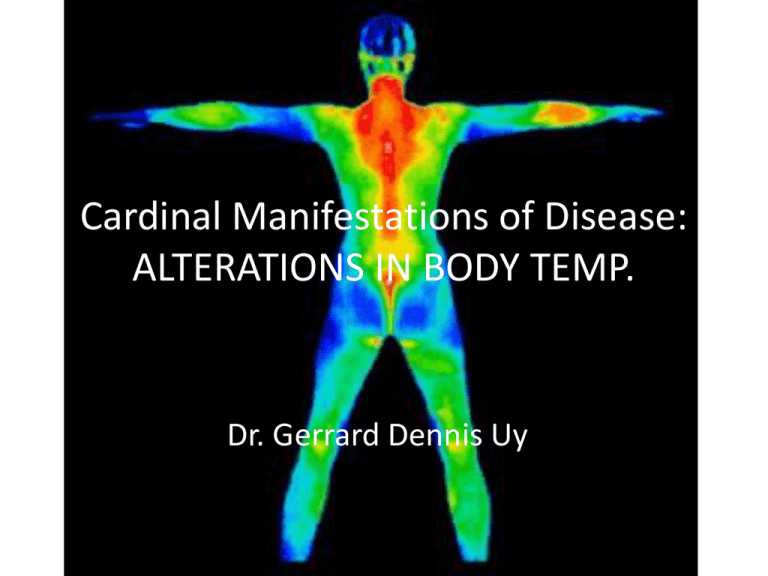
Cardinal Manifestations of Disease: ALTERATIONS IN BODY TEMP. Dr. Gerrard Dennis Uy Fever and Hyperthermia • hypothalamic thermoregulatory center – regulates body temperature (core BT 37 C) • A.M. temperature of >37.2°C (>98.9°F) or a P.M. temperature of >37.7°C (>99.9°F) would define a fever • Rectal temperatures are generally 0.4°C (0.7°F) higher than oral readings Fever • Elevation of body temperature that exceeds the normal daily variation • occurs in conjunction with an increase in the hypothalamic set point • Vasoconstriction in hands and feet shunts blood to the internal orgrans • shivering = heat conversion and production • until the temperature of the blood bathing the hypothalamic neurons matches the new thermostat setting Fever • Pathogenesis – Pyrogen – any substance that causes fever • Exogenous (microbial products, microbial toxins, or whole microorganisms) – E.g. LPS endotoxin – gram negative bacteria • Endogenous a.k.a Pyrogenic cytokines (IL-1, IL-6, tumor necrosis factor (TNF), ciliary neurotropic factor (CNTF), and interferon (IFN) ) – Elevation of Hypothalamic Set point • levels of prostaglandin E2 (PGE2) are elevated in hypothalamic tissue and the third cerebral ventricle Hyperthermia • uncontrolled increase in body temperature that exceeds the body's ability to lose heat • setting of the hypothalamic thermoregulatory center is unchanged • does not involve pyrogenic molecules • Exogenous heat exposure and endogenous heat production Hyperthermia • Can be rapidly fatal • Does not respond to antipyretics The Decision to Treat Fever • Most fevers are associated with self limiting infections • There is no significant clinical evidence that antipyretics delay the resolution of viral or bacterial infections nor there is evidence that fever facilitates recovery from infection • Fever can provide important diagnostic clues in different disease conditions The Decision to Treat Fever • The objective in treating fever is to reduce the elevated set point and to facilitate heat loss • Reducing fever also reduces systemic symptoms • Treatment of fever in some patients is highly recommended (cadiac, cerebrovascular, and pulmonary diseases) Mechanism of antipyretics • Acts by reducing the level of PGE2 • Common antipyretics – Acetaminophen – Aspirin – NSAIDS – glucocorticoids FEVER and RASH Approach to the patient with fever and rash • A thorough history if often needed • Includes: – – – – – – Immune status Medications taken within the previous month Travel history Immunzation status Exposure to domestic pets Recent exposure to ill individuals • The history should also include onset and direction and rate of spread Types of lesions • • • • • Macules - flat lesions defined by an area of changed color Papules - raised, solid lesions <5 mm in diameter plaques ->5 mm in diameter with a flat, plateau-like surface nodules ->5 mm in diameter with a rounded configuration Wheals (urticaria, hives) - papules or plaques that are pale pink and may appear annular (ringlike) as they enlarge • Vesicles (<5 mm) and bullae (>5 mm) are circumscribed, elevated lesions containing fluid • Pustules are raised lesions containing purulent exudate Types of lesions • Nonpalpable purpura: - flat lesion that is due to bleeding into the skin. – <3 mm --- petechiae – >3 mm --- ecchymoses MACULES PAPULES PLAQUES NODULES PUSTULES WHEALS VESICLES BULLA PETECHIAE ECCHYMOSES RUBEOLA • Also known as measles/first dse • Caused by paramyxovirus • rash starts at the hairline 2–3 days into the illness and moves down the body, sparing the palms and soles • Associated with cough, conjunctivitis, coryza, and severe prostration • Koplik's spots - seen during the first 2 days RUBEOLA • Infection is spread by contact with droplets from the nose, mouth, or throat of an infected person • Sneezing and coughing can put contaminated droplets into the air. • Resolves spontaneously after 1-2 weeks RUBELLA • also known as German measles/3rd disease or 3 day measles • Caused by togavirus • also spreads from the hairline downward, but tend to clear from originally affected areas as it migrates, and it may be pruritic • Usually accompanied by postauricular, suboccipital and posterior cervical lymphadenopathy RUBELLA • Forschheimer spots – red spots (petechiae) seen on the soft palate in 20% of patients – Not diagnostic of rubella ERYTHEMA INFECTIOSUM • • • • also known as the fifth disease Caused by human parvovirus B19 primarily affects children 3–12 years old develops after fever has resolved as a bright blanchable erythema on the cheeks (slapped cheek appearance) – more diffuse rash (often pruritic) appears the next day on the trunk and extremities and then rapidly develops into a lacy reticular eruption that may wax and wane over 3 weeks ERYTHEMA INFECTIOSUM • Only supportive treatment • No known complications SLE • typically develop a sharply defined, erythematous eruption in a butterfly distribution on the cheeks (malar rash) • Etiology is autoimmune Still’s Disease • Juvenile rheumatoid arthritis • manifests as an evanescent salmon-colored rash on the trunk and proximal extremities that coincides with fever spikes • Etiology unknown Fever of Unknown Origin (FUO) Classic Definition • 1) temperatures of >38.3°C (>101°F) on several occasions • (2) a duration of fever of >3 weeks • (3) failure to reach a diagnosis despite 1 week of inpatient investigation Fever of Unknown Origin New Classification • (1) classic FUO • (2) nosocomial FUO • (3) neutropenic FUO • (4) FUO associated with HIV infection Classic FUO • temperatures of >38.3°C on several occasions • a duration of fever of >3 weeks • 3 outpatient visits or 3 days in the hospital without elucidation of a cause or 1 week of "intelligent and invasive" ambulatory investigation • CAUSES: – – – – Undiagnosed – 30% Infections (e.g. Tuberculosis) – 26% Non-infectious Inflammatory (e.g.PR, SLE)– 24% Neoplasms – 12.5% FUO • Nosocomial FUO – more than 50% are infected – Intravascular lines, septic phlebitis, and prostheses are all suspect – Multiple blood, wound, and fluid cultures are mandatory – Threshold for CT scans, ultrasonography, 111In WBC scans, noninvasive venous studies is low FUO • Neutropenic FUO - neutrophil coun < 500/ul – Neutropenic patients are susceptible to focal bacterial and fungal infections, to bacteremic infections, to infections involving catheters (including septic thrombophlebitis), and to perianal infections – Candida and Aspergillus infections are common – 50–60% of febrile neutropenic patients are infected, and 20% are bacteremic FUO • HIV- associate FUO – Due to HIV alone – due to Mycobacterium avium or Mycobacterium intracellulare, tuberculosis, toxoplasmosis, CMV infection, Pneumocystis infection, salmonellosis, cryptococcosis, histoplasmosis, non-Hodgkin's lymphoma, and (of particular importance) drug fever Hypothermia and Frostbite • Accidental hypothermia - unintentional drop in the body's core temperature below 35°C • Primary accidental hypothermia is a result of the direct exposure of a previously healthy individual to the cold • Secondary hypothermia is a result from complication of a serious disorder Hypothermia • Causes: – Climate – Endocrine dysfunction – Adrenal insufficiency – Hypopituitarism – Neurologic injury – sepsis Hypothermia • Heat loss occurs through five mechanisms: – radiation (55–65% of heat loss) – conduction (10–15% of heat loss, but much greater in cold water) – convection (increased in the wind) – Respiration – evaporation (which are affected by the ambient temperature and the relative humidity) Hypothermia • Hypothermia is confirmed by measuring the core temperature, preferably at two sites. – Rectal probes should be placed to a depth of 15 cm – Simultaneous esophageal probe placed 24 cm below the larynx • cardiac monitoring should be instituted, along with attempts to limit further heat loss • Supplemental oxygenation is always warranted • NGT, FBC • Establish IV line with warm saline BACK AND NECK PAIN Anatomy Review • Anterior portion of the spine consist of cylindrical vertebral bodies separated by intervertebral disks • The disks are responsible for 25% of spinal column strength • The function of the anterior spine is to absorb shock of body movements Anatomy Review • The posterior portion of the spine consists of the vertebral arches and seven processes • The function of the posterior spine is to protect and spinal cord and nerves and to stabilize the spine by providing sites for attachments of muscles and ligaments • Nerve root injury (radiculopathy) is a common cause of neck, arm, and low back and leg pain • Pain sensitive structures in the spine: – Periosteum of the vertebra – Dura – Facet joints – Annulus fibrosus – Epidural veins – Posterior longitudinal ligaments Types of back pain • Local Pain – Caused by stretching of pain sensitive structures that compress or irritate sensory nerve endings • Pain referred to the back – May arise from abdominal or pelvic viscera – Usually unaffected by posture – Nonspecific back pains Types of back pain • Pain of spine origin – Diseases affecting the upper lumbar spine tend to refer pain to the lumbar region, groin, or anterior thighs – Diseases affecting the lower lumbar spine tend to refer pain to the buttocks, posterior thighs, calves • Radicular back pain – Sharp and radiates from the lumbar spine to the leg – Pain may increase in postures that stretch the nerves and nerve roots Examination of the back • Straight leg – raising test (SLR test): – Also called lasegue test – to determine whether a patient with low back pain has an underlyingherniated disk, mostly located at L5 – With the patient lying flat, passive flexion of the extended leg at the hip stretches the L5 and S1 nerve roots and the sciatic nerve – Positive if the maneuver reproduces the usual back or limb pain Examination of the back • Crossed SLR sign – Less sensitive but more specific for disk herniation – Positive when flexion of one leg reproduces the pain in the opposite leg or buttocks • Reverse SLR sign – Elicited by standing the patient next to the examination table and passively extending each leg with the knee fully extended – Positive if the patient’s usual back or limb pain is reproduced Common Causes of Back Pain • Congenital Anomalies: – Spondylosis: • A bony defect of the vertebra • Usually bilateral • Most common cause of persistent low back pain in adolescents • Often activity related – Spondylolisthesis: • Anterior slippage of the vertebral body, pedicles, and superior articular facets, leaving the posterior elements behind • Occurs more frequently in women • Congenital Anomalies cont – Spina bifida • Failure of closure of one or several vertebral arches posteriorly • The meninges and spinal cord are normal – Tethered cord syndrome • Usually presents as a progressive cauda equina disorder • Patient is often a young adult who complains of perineal or perianal pain Common Causes of Back Pain • Trauma – Patients may have a spinal fracture or dislocation • Sprains and Strains – Usually minor self limiting injuries associated with lifting a heavy object, a fall, or a sudden deceleration – Pain is usually confined to the lower back – No radiation present Common Causes of Back Pain • Lumbar Disk Disease – Most likely to occur at the L4-L5 and L5-S1 levels – Cause is unknown – Risk is increased in overweight individuals – Degeneration of the nucleus pulposus and annulus fibrosus increases with age – Pain is usually located in the low back and maybe referred to the leg, buttock, or hip Neck • Neck pain usually arises from diseases of the cervical spine and soft tissues of the neck • Causes of neck pain: – Trauma – Cervical Disk Disease – Cervical Spondylosis Cervical Disk Disease • Presents with neck pain, stiffness, and limited range of motion • Spurling’s Sign – extension and lateral rotation of the neck reproduces symptoms • Cervical disk herniations are usually posterolateral • For the next meeting, read on Cardinal Manifestations of Disease : DYSPNEA • Harrison’s Principles of Internal Medicine 17th edition


